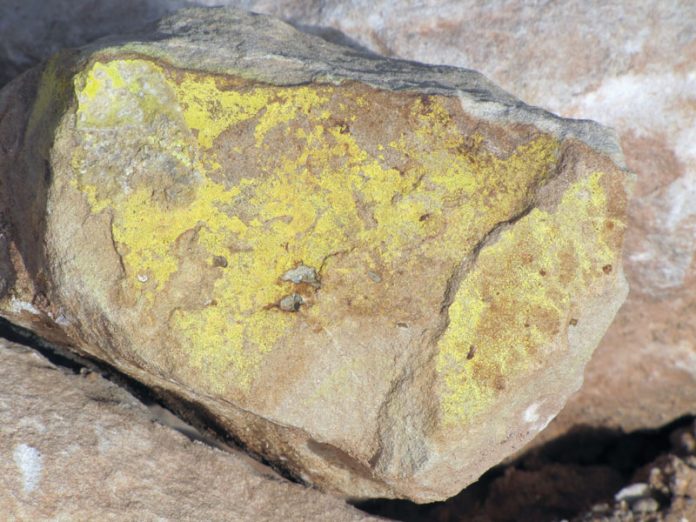
Carnotite can claim a unique distinction among ore minerals: It has been mined for three different mineral commodities at three different times. Although uncommon, carnotite occasionally occurs in minable concentrations, the richest of which are located in the canyon-and-mesa sandstone formations of western Colorado and eastern Utah. These formations initially contained normal background traces of uranium. Their porosity permitted the circulation of large volumes of uranium-rich groundwater, while an abundance of carbon-rich organic matter chemically precipitated the uranium from the solution as rich deposits of carnotite.
Describing Carnotite
French mineralogists first described carnotite in 1899 from Colorado specimens and named it for French chemist and mining engineer, Marie Adolphe Carnot. French (Polish-born) chemist, Marie Curie, had recently discovered that uranium minerals contained traces of the extremely rare and intensely radioactive element radium. When medical researchers learned that the radiation emitted by radium seemed to halt the growth of cancerous cells in humans, radium demand soared and prospectors rushed to the Colorado- Utah sandstone country to discover many rich, shallow carnotite deposits.
Radium

By 1900, Colorado-Utah carnotite ores were providing most of the world’s radium. Radium, which is extremely rare, then cost about $128,000 per gram ($3.3 million in 2020 dollars). By the 1920s, Colorado-Utah miners had recovered 250 grams of radium (just nine ounces!) from 100,000 tons of highgrade carnotite ore. By then, rich, plentiful uranium ores from the Belgian Congo (now the Democratic Republic of the Congo) had taken over the radium market.
Nevertheless, carnotite mining in Colorado and Utah increased, this time as a source of vanadium, a hard, silvery-white metal that enhances the durability of steel. Vanadium was most famously used in the steel of Henry Ford’s legendary Model A automobiles. Miners subsequently reworked old carnotite waste dumps and developed many new mines. During the 1930s, more than 200 Colorado-Utah mines were shipping carnotite ore to six vanadium mills.
Nuclear Weapons
But carnotite’s greatest value as an ore came after World War II had ushered in the age of nuclear weapons. In 1947, the newly created Atomic Energy Commission (AEC) sought to develop secure domestic sources of what had become the ultimate strategic material—uranium. When the AEC offered huge subsidies for discovering and mining uranium ore, carnotite, at least from the standpoint of prospectors and miners, became as good as gold.
Thousands of miners, fortune hunters, and speculators descended upon the Colorado-Utah sandstone country in the nation’s last, great mineral rush that would give the independent prospector a chance to strike it rich. And, using new, portable Geiger-Müller counters and scintillators that detected carnotite’s radioactivity, some did make their fortune.
The jackpot for miners was “carnotite trees”—petrified tree trunks within the sandstone. Over millions of years, residual carbon in these trunks had precipitated remarkably rich, concentrations of carnotite. Although uncommon, some of these trunks consisted of more than 50 percent carnotite by weight, weighed many tons, and were worth $100,000 each.
Mining Subsides
By 1955, some 800 Colorado-Utah uranium mines were shipping carnotite ore. But with the nation awash in uranium, federal mining subsidies were rescinded in 1957 to end the rush. By then, 400 million tons of ore, mostly carnotite, had yielded more than 200,000 tons of elemental uranium.
Over three different periods, carnotite has served as an ore of radium, vanadium, and uranium. And specimens are still easy to collect in the old Colorado-Utah mining districts. With their bright-yellow color, carnotite specimens are quite unusual—as is the story behind them.
CARNOTITEHydrous Potassium Uranyl Vanadate K2(UO 2 ) 2 (VO 4 ) 2·3H O] A secondary mineral that occurs as bright-yellow encrustations and vein fillings. It crystallizes in the monoclinic system, but crystals are rare and form only tiny grains. Carnotite has a Mohs harness of 2.0, an earthy-to-resinous luster, and a relatively high specific gravity of 4.70. Its best field marks are its bright-yellow color and easily detected radioactivity.
|
This rock science column about carnotite uses previously appeared in Rock & Gem magazine. Click here to subscribe! Story by Steve Voynick.















